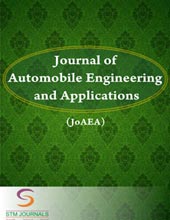Open Access

C. Armenta-Déu

D. Torres
- Facultad de Ciencias Físicas Universidad Complutense de Madrid. 28040 Madrid Spain
- Facultad de Ciencias Físicas Universidad Complutense de Madrid. 28040 Madrid Spain
Abstract
This works develops a simulation model to predict the performance of direct current electric motors for electric vehicles (EV), mainly focused on the required power and mechanical torque as a function of the driving conditions. The simulation, therefore, has been based on the dynamic conditions of the electric vehicle to reproduce the current driving in urban routes or intercity travels. The model has been applied to synchronous and asynchronous transmission system. The results has proved that the performance of an electric vehicle engine can be predicted using characteristic parameters of the driving like the acceleration rate and vehicle speed, as well as of the environmental conditions, such as wind force and tire to road friction. The aerodynamic profile and the mass of vehicle have also been included in the simulation predictive model. The simulation has proved that there is not a unique option that makes the electric motor working better in all conditions, since in some cases is the synchronous transmission which generates higher performance, while in other cases is the asynchronous. At the acceleration mode, either in flat terrain or in ramp or descent road, the synchronous transmission system is more suitable, while for constant speed in flat terrain the asynchronous transmission works better, as well as at constant speed in ramp or descent road.
Keywords: Electric vehicle. Engine performance. Power simulation. Synchronous and asynchronous transmission system.
[This article belongs to Journal of Automobile Engineering and Applications(joaeaa)]
Browse Figures
References
1. Electric motors as alternative to combustion engines. DAIMLER. Global Media Site, November 9, 2007.
2. John W. Brennan, Timothy E. Barder (2016) Battery Electric Vehicles vs. Internal Combustion Engines. A United States-Based Comprehensive Assessment. D. Little, www.adlittle.com/ BEV_ICEV.
3. Electric Vehicle Basis, Us Department of Energy (DOE), Office of Energy Efficiency and Renewable Energy, DOE/GO-102021-5606, August 2021.
4. Andrew Burke (2014) Power and Energy Requirements for Electric and Hybrid Vehicles, Hybrid and Electric Powertrains, Energy Sources: Batteries, https://doi.org/10.1002/9781118354179. auto063.
5. Tom Denton (2020) Electric and hybrid vehicles. Ed. Routledge, 2nd. Ed. ISBN 9780367273231
6. https://afdc.energy.gov/vehicles/
7. What types of motors are used in Electric Vehicles?. PrimecomTech. https://www.primecom. tech/blogs/news/what-types-of-motors-are-used-in-electric-vehicles [Accessed on November, 9th ,2021]
8. Sri Hari Karthik (2019) Types of Motors used in Electric Vehicles, Circuit Digest, https://circuitdigest.com/electric-vehicles
9. Mertens, K and Hanser K.F., (2011) Photovoltaics: Fundamentals, Technology and Practice, Chapter 7, Section 7.2.4 Efficiency of Inverters, pp. 177–181
10. Chris Mi, M. Abul Masrur, Hybrid Electric Vehicles, Ed. John Wiley and Sons, 2017, ISBN 10: 111897056X; ISBN 13: 9781118970560
11. Measuring DC/DC converter efficiency, QOITECH, February, 2018, https://www.qoitech.com/ techpapers/measuring-dc-dc-converter-efficiency/[Accessed November, 9th, 2021]
12. [Available from] https://ev-database.org/
13. [Available from] https://www.volkswagen.com/
14. [Available from] https://www.hyundai.com/
15. [Available from] https://www.renault.com/
16. [Available from] https://www.opel.com/
17. [Available from] https://www.kia.com/
18. [Available from] https://www.nissan.com/
19. [Available from] https://www.mazda.com/
20. [Available from] https://www.peugeot.com/
21. [Available from] https://www.skoda.es/
22. [Available from] https://www.bmw.com/
23. [Available from] https://www.audi.com/
24. [Available from] https://www.citroen.com/
25. [Available from] https://www.mg.co.uk/

Journal of Automobile Engineering and Applications
| Volume | 8 |
| Issue | 3 |
| Received | November 11, 2021 |
| Accepted | November 27, 2021 |
| Published | January 27, 2023 |

